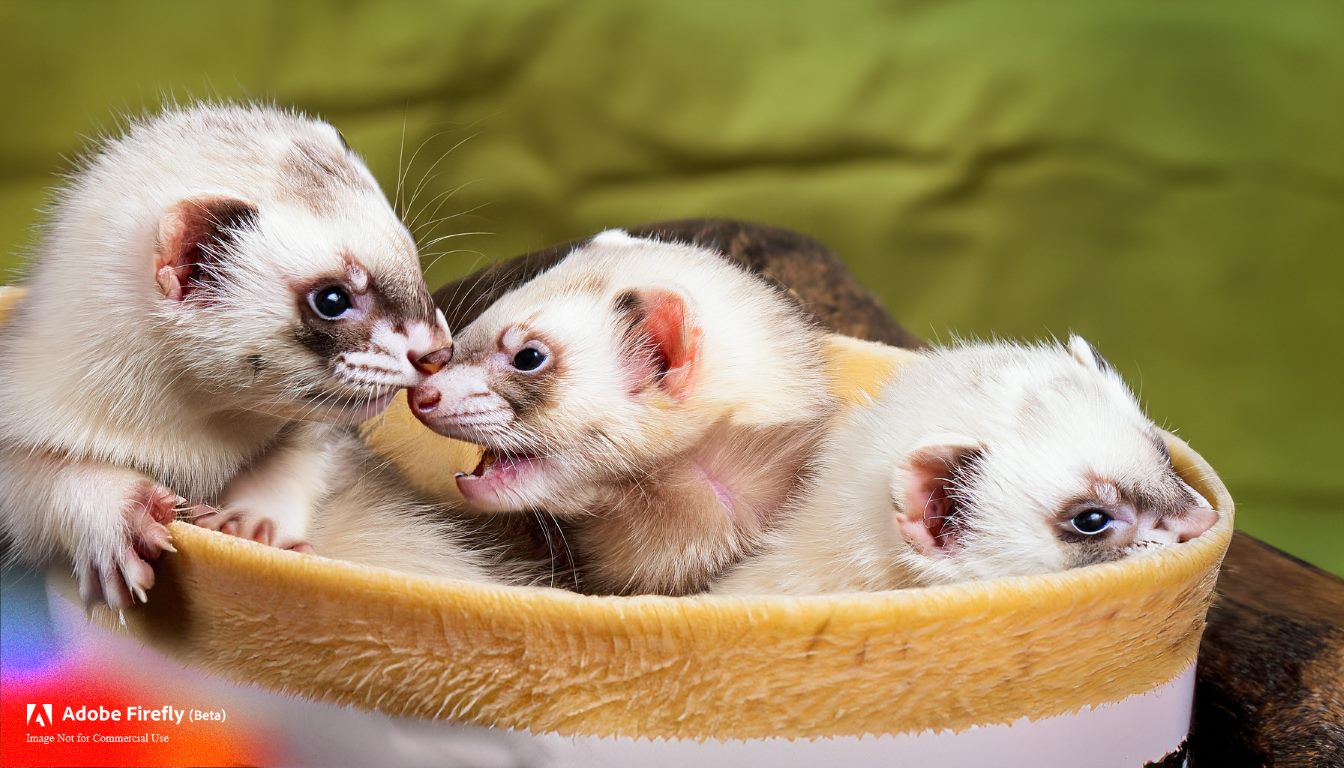
Ferrets are always fun to watch, but especially so when they are babies. It’s fascinating to watch kits go through their infancy, childhood, and teens.
When a kit comes forth from its mama, it weighs less than a half ounce (usually between 0.35 and 0.42 oz). Imagine – a new living being weighing just slightly more than a U.S. quarter.
A ferret pregnancy lasts only 42 days and when the kit is born it is only two inches long. Usually there are about six to eight kits in a litter, but there could be as few as one or as many as 15. A female ferret can have one to two litters by natural means annually but up to five with techniques such as adjusting lighting and heat to “trick” her reproductive system into a fertile stage. (Such techniques should be left to breeders and other ferret experts.)
At birth, a ferret kit is deaf and blind and has nearly no fur on their pink bodies, except for some fine white threads. Pretty soon, however, the “peach fuzz” starts to come in and it starts to turn color within the first week of life. If your fuzzy-wuzzy is going to remain an all white (albino) pet, you’ll know by then.

For the first three weeks of its life, a kit is totally dependent on its mother, who will nurse it and see that it is safe and warm. She’ll carry her kit around by the scruff of the neck (always a delight to watch.) The kit won’t even open its eyes for about three weeks. However, at that point, things begin to change quickly.
By the end of its first month, your kit will be covered in fur and weigh about a half pound (8 oz) rather than a half ounce. It can see and hear and will begin to take its first steps toward independence. This is an ideal time to introduce your kit to others in the household. Start by placing the kits’ cage close to those of other ferrets. That way, they will get used to each others’ scents. After a few days, let the ferrets play together intermittently for a few minutes at a time. Lengthen those periods little by little as you see them get more comfortable with each other. Of course, separate them if they start to bite or fight each other.
At the same age, you can introduce kits to humans. Simply take them out and very gently cuddle with them for a few minutes at a time, all the while speaking very softly to them.
At roughly 1½ months, kits can be weaned and start having solid ferret food that has been well soaked in water. The food should become thicker as the kit’s teeth grow and mature. A kit has 30 baby teeth, which will gradually be replaced by 34 adult teeth at about nine months.
Any baby needs to be toilet trained at some point. Watch your kit to see where it prefers to toilet. Place the litter box there and encourage its use. When you see your kit toileting elsewhere, move quickly to place it in the box.

A ferret kit is just like other children in that it likes to explore the world with its mouth. If there is a way to taste something, a kit will try it. It needs to learn to use those teeth and will nip or bite. The prime time for this is generally between four and six months of age, so this is also the time to start training your kits out of this trait. Keep in mind that nipping and biting are also the means kits use to establish the “pecking order” among its siblings. It really is part of growing up in the ferret world.
With proper training and care, most nipping and biting will decrease as kits reach adulthood at about eight months. However, many ferrets love nipping and chewing on their bedding, toys and other items throughout life.
Just as you would take an infant to a pediatrician, a ferret kit needs to see a veterinarian. The vet will need to check for parasites, fleas, ear mites, and any birth defects. The vet will also give a variety of vaccinations: Distemper at two and three months, rabies at three and four months.
When a ferret reaches adulthood (at about eight months), an adult male ferret (a hob) weighs about five pounds while an adult female (a jill) weighs about 2 ½ pounds. (When neutered, which is highly recommended, an adult male weighs about three pounds and an adult female is about 1 ½ pounds).
After neutering, the incision site will need to be kept clean as long as it can be seen. Fortunately, this can be done simply by wiping the area with hydrogen peroxide. Contact the vet if the area becomes red or swollen.
As you can see, ferret kits are like any other type of children – a lot of work but cute enough to be worth the effort. The time and effort you spend in training your kit will pay off in many fun and rewarding years together.






